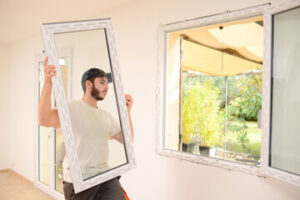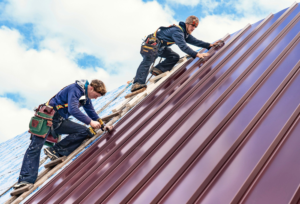Window Replacement Massachusetts involves replacing the existing windows in your home. You can opt for full frame window replacements, which require removing exterior and interior trim, or insert windows, which slide into the existing frames without removal.

When choosing a window company, look for one that offers the widest range of options for frame, glass and hardware. This can help ensure that your windows match the rest of your home.
The frame of a window keeps the panes in place, holds them to the wall and helps the windows stay energy efficient. Window frames are available in a wide variety of materials and each type has its own unique benefits.
When it comes to choosing a frame, consider your personal style, climate and home maintenance needs. Also, be sure to take into account the durability of each material and how it will hold up over time.
There are two main types of frame styles: full frame and split frame. A full frame is the more traditional option, while a split frame is more commonly used for new constructions.
Both styles can be used for a replacement window or as part of a complete renovation project. Full frame replacements require removing the existing casings, jambs and trim from the entire wall to give way to the new window. This type of install is best when your window is in a load-bearing wall or when you are looking for a more dramatic appearance.
If your window is in a non-load-bearing wall or you would like to preserve the original look of your home, an insert installation may be a good option for you. This is where the old sash, operating hardware and covers are removed, but the frame itself remains intact. The new window is then inserted into the opening, anchored, insulated and sealed to the surrounding wall.
When selecting a frame, you will also need to choose the necessary hardware for your window replacement. There are a wide variety of options and the best choice will depend on your specific requirements and budget. For example, if you want your windows to be secure, you will need to choose locking handles and hinges that match your new window frame. You can also get decorative or functional hardware to complement your frame design. For example, decorative window grids can add a charming touch to your windows while reducing the amount of light that passes through them. Other useful hardware includes window screens and shutters, which can help improve your home’s energy efficiency.
Glass
The window glass in your home may need replacing, whether it’s broken from a football practice gone wrong or simply worn out over time. This is also a good opportunity to upgrade to energy efficient double or even triple pane windows, which will improve the overall insulation and look of your home.
If your existing window’s seal has failed, you will notice condensation or fog between the windows. This is an indication that the special seals that keep argon or krypton gas in between the windows have deteriorated and allow air to leak into your home. This is not a problem that can be resolved by replacing the window glass alone, but will need to be repaired as part of a complete sash replacement or repair.
Muntins and mullions are pieces of wood that sit in between your window panes making a cross-like pattern. While they are mostly decorative, they do help support the panes of your windows. If they are damaged or rotting, it’s important to repair them before the underlying wood starts rotting and weakening the frame of your windows.
When replacing window glass, it’s crucial to use safety glass for both durability and visibility. Safety glass is laminated or tempered, which makes it stronger and more resistant to breakage. It’s also treated with coatings that reduce glare and offer additional insulation benefits.
It’s a great idea to have new glazing compound ready when you replace window glass. If you don’t have it, you can purchase it from hardware stores or home improvement centers. Use a caulking gun to apply the compound in the L-shaped grooves on each side of your glass, then press the new pane into place and use your finger to smooth out any rough edges.
Replacing a window isn’t just about improving the look and feel of your home, it’s also about increasing your property value and curb appeal. If you’re not sure if you should repair or replace your window, talk to a professional glazier who can advise you on the best solution. They’ll be able to help you choose the most cost-effective and energy-efficient option for your home.
Sash
Window sashes are designed to keep the glass panes in place and to slide up and down, opening and closing. When a window sash becomes unsteady or is damaged, it can let water or air into your home or prevent your windows from functioning properly. Window sashes can be made of wood, aluminum, or vinyl. Each material has different benefits and costs associated with it.
Window sash replacement kits are available at many big-box hardware stores. These kits are designed to replace the top or bottom sash in a double-hung window and are easy for homeowners to install. However, if you have never performed this type of home renovation before it may be best to consult with a professional to avoid any potential issues.
There are several signs that your window sashes may need to be replaced. A sash that does not move smoothly or requires force to open can be indicative of dirt build-up and warping of the sash frame. A sash that does not close or seal properly can lead to drafts in your home and higher energy bills. Visible damage to the sash, such as cracks or holes should also be remedied as soon as possible.
Some homeowners opt to only replace the window sash, rather than the entire window. This can be a more cost-effective solution depending on the condition of your existing window frame and the energy efficiency upgrades you’re looking for.
A new sash can provide improved appearance, increased functionality, and energy savings. You can choose between aluminum, vinyl, or wood sashes to match the aesthetics of your home. Wood sashes can be stained or painted for a more custom look. Vinyl is the most budget-friendly option and is durable and low-maintenance.
A regular schedule of maintenance can help keep your windows in good condition. Dust your windows regularly using a vacuum attachment and wipe down the sash tracks and frames each week. This will eliminate build-up and ensure your windows are able to open and close smoothly. Check the weather stripping around your windows for wear and tear every few months and replace it when needed to maintain a tight seal between the interior and exterior of your home.
Hardware
When you hear the term “window hardware,” your first thought may be of curtain rods or holdbacks. However, window installation companies use the term to refer to the latches, locks, hinges and handles that allow windows to open, close and operate properly. High-quality window hardware is important to ensure proper function, improved aesthetics and reduced energy costs.
Window hardware comes in various shapes, sizes and finishes to suit a variety of styles and decors. Some styles can even be incorporated into decorative accents in your home for added flair. It’s also important to choose quality window hardware that is rated for outdoor use. Hardware that is not rated for outside use can be damaged or rusted over time by the elements.
The most common types of window hardware are handles, handles covers and hinges. Window handles are used to open and close the sash. If the handle is not functioning properly, it may be a sign that you need to replace your operator. Window handles are available in a variety of finishes to complement your home’s design, including brushed nickel, oil-rubbed bronze and classic black. You can even find window handles that are designed to match your shutters for a cohesive look.
Hinges are important to the operation of your windows and can be a source of frustration when they become rusted, broken or worn down from frequent use. Whether your windows are casement or double-hung, you’ll need a set of hinges to keep them functioning smoothly. You can purchase a replacement hinge for your window from a variety of home improvement stores or online retailers.
When choosing window replacement parts, consider the size of your window and your budget. Full-frame replacement windows are designed for new construction and major remodeling projects. They are installed in the rough opening and have a nailing flange that attaches to the existing wall system. Insert replacement windows, on the other hand, fit into an existing frame. They are smaller than full-frame replacement windows and don’t include any exterior trim.
